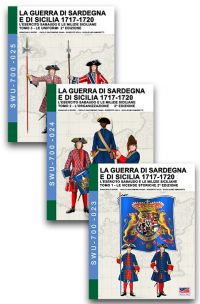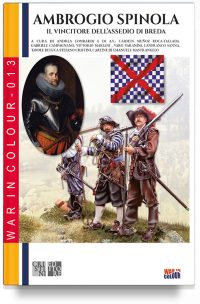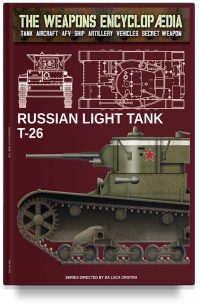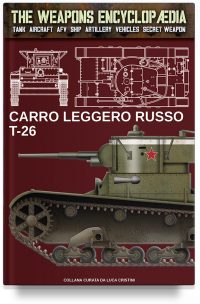-
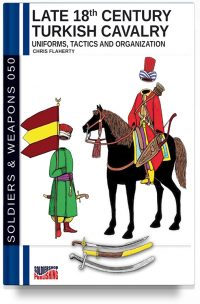
Late 18th Century Turkish Cavalry
- €29,00
- A hallmark of late 18th Century Turkish style of warfare was an initial attack by thousands of massed Cavalry as the main offensive force on the battlefield. Regarded as the best in Europe, and feared with some justification for their sword mastery and valor in battle, European tactics changed in the face of the Turkish Cavalry threat. The Kapikulu Ocaklari: Standing Army’s Cavalry consisted of Sultan’s Household Guard Regiments, Zirkhli: Cuirassier - Armoured Sipahi, Sipahi Light Cavalry or Lancers; Deli;…
-
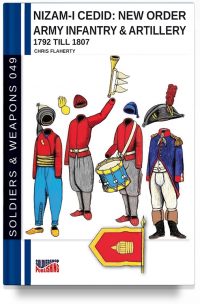
Nizam-I Cedid: New order Army infantry & artillery 1792 till 1807 (Turkish Army)
- €29,00
- This book looks at uniforms, rank-system, and organization for a new type of Turkish Soldier, other than Janissary providing the main Soldier-type during the French Revolution, and Early Napoleonic Wars. Debut of the Levend Chiftlik Regiment in 1799, during the French siege of Acre, and in the British-Turkish campaign in Egypt to expel the French occupation, introduced the Nizam-i Cedid: New Order Army. Having its beginning as part of the reforms of Sultan Selim III (1789 till 1807), several Anatolian…
-
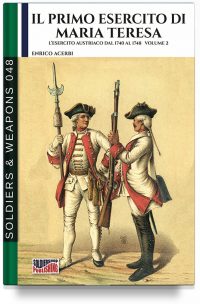
Il primo esercito di Maria Teresa – Vol. 2
- €32,00
- Maria Teresa d’Austria fu, con Federico il Grande, certamente una delle figure più importanti della storia europea. In questo lavoro parlerò, essenzialmente, solo del primissimo periodo in cui l’armata imperiale austriaca fu, in senso propriamente detto “teresiano”, cioè dal 1740 fino alla fine della “guerra degli Otto anni”, ovvero il 1748. Un aspetto particolarmente tragico di quel periodo fu che una donna, Maria Teresa, in origine certamente poco avvezza a tutto quando comprendeva l’attività bellica, fu costretta, da circostanze straordinarie,…
-
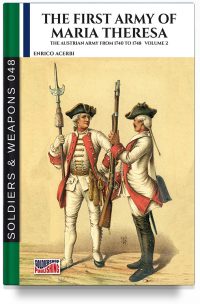
The first army of Maria Theresa – Vol. 2
- €32,00
- Maria Theresa of Austria was, with Frederick the Great, certainly one of the most important figures in European history. In this paper, I will essentially only discuss the very first period in which the Austrian imperial army was, in the proper sense, ‘Theresian’, i.e. from 1740 until the end of the ‘Eight Years’ War’, i.e. 1748. A particularly tragic aspect of that period was that a woman, Maria Theresa, originally certainly unaccustomed to anything when it came to the business…
-
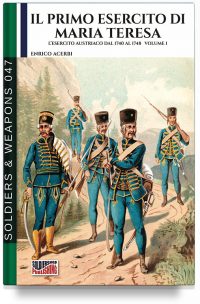
Il primo esercito di Maria Teresa – Vol. 1
- €32,00
- Maria Teresa d’Austria fu, con Federico il Grande, certamente una delle figure più importanti della storia europea. In questo lavoro parlerò, essenzialmente, solo del primissimo periodo in cui l’armata imperiale austriaca fu, in senso propriamente detto “teresiano”, cioè dal 1740 fino alla fine della “guerra degli Otto anni”, ovvero il 1748. Un aspetto particolarmente tragico di quel periodo fu che una donna, Maria Teresa, in origine certamente poco avvezza a tutto quando comprendeva l’attività bellica, fu costretta, da circostanze straordinarie,…
-
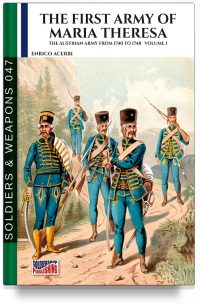
The first army of Maria Theresa – Vol. 1
- €32,00
- Maria Theresa of Austria was, with Frederick the Great, certainly one of the most important figures in European history. In this paper, I will essentially only discuss the very first period in which the Austrian imperial army was, in the proper sense, ‘Theresian’, i.e. from 1740 until the end of the ‘Eight Years’ War’, i.e. 1748. A particularly tragic aspect of that period was that a woman, Maria Theresa, originally certainly unaccustomed to anything when it came to the business…
-
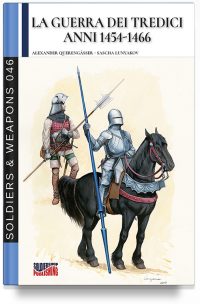
La guerra dei tredici anni 1454-1466
- €29,00
- Fratelli cavalieri ed eserciti mercenari dell’Europa baltico-teutonica nel XV secolo La guerra dei tredici anni (in tedesco Dreizehnjähriger Krieg; in polacco Wojna trzynastoletnia), conosciuta anche col nome di guerra delle città, fu combattuta dal 1454 al 1466. Essa ebbe iniziò con una sollevazione delle città, borghi e castelli della Prussia e della nobiltà locale con lo scopo di ottenere l’indipendenza dai cavalieri teutonici. La costituenda Confederazione prussiana chiese aiuto al re della Polonia Casimiro IV , il quale in cambio…
-
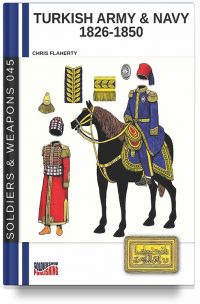
Turkish army & navy 1826-1850
- €32,00
- This book looks at the development and organization of Turkish Army, Navy and Police uniforms from 1826 till the early 1850s. In 1826, use of Janissary as the main Soldier-type ended and new Soldiers were uniformed, organized, equipped and trained according to a European Model Army design. In 1826, following crushing of the Janissary Revolt, and their formal disbandment, the new Mansure Army, was formed under Abdul Mahmud II, 30th Sultan of the Ottoman Empire. Reforms continued throughout the first…
-
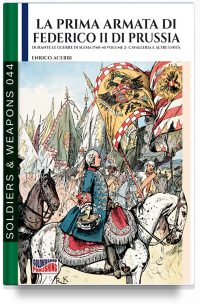
La prima armata di Federico II di Prussia – Vol. 2
- €32,00
- Federico il Grande fu una delle figure più importanti della storia europea. Era, nel XVIII secolo, il monarca di uno stato tedesco, la Prussia, che aveva pochi vantaggi e tanti piccoli territori sparsi da est (Prussia orientale) ad ovest sul Reno (ducato di Kleve). La sua era una nazione relativamente piccola circondata da Francia, Austria, Svezia e Russia, tutte ostili agli interessi della Prussia. Questi due volumi parlano degli inizi del regno di Federico II e dello sviluppo da lui…
-
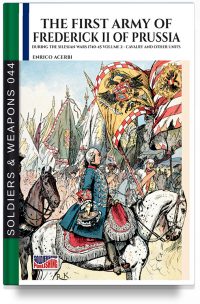
The first army of Frederick II of Prussia – Vol. 2
- €32,00
- Frederick the Great was one of the most important figures in European history. He was, in the 18th century, the monarch of a German state, Prussia, which had few advantages and many small territories scattered from the east (East Prussia) to the west on the Rhine (Duchy of Kleve). His was a relatively small nation surrounded by France, Austria, Sweden and Russia, all hostile to Prussian interests. These two volumes discuss the beginnings of Frederick II's reign and the development…
-
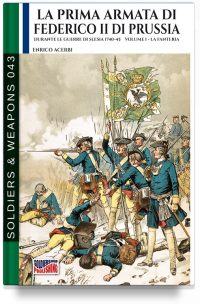
La prima armata di Federico II di Prussia – Vol. 1
- €32,00
- Federico il Grande fu una delle figure più importanti della storia europea. Era, nel XVIII secolo, il monarca di uno stato tedesco, la Prussia, che aveva pochi vantaggi e tanti piccoli territori sparsi da est (Prussia orientale) ad ovest sul Reno (ducato di Kleve). La sua era una nazione relativamente piccola circondata da Francia, Austria, Svezia e Russia, tutte ostili agli interessi della Prussia. Questi due volumi parlano degli inizi del regno di Federico II e dello sviluppo da lui…
-
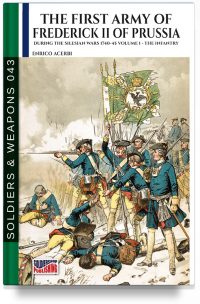
The first army of Frederick II of Prussia – Vol. 1
- €32,00
- Frederick the Great was one of the most important figures in European history. He was, in the 18th century, the monarch of a German state, Prussia, which had few advantages and many small territories scattered from the east (East Prussia) to the west on the Rhine (Duchy of Kleve). His was a relatively small nation surrounded by France, Austria, Sweden and Russia, all hostile to Prussian interests. These two volumes discuss the beginnings of Frederick II's reign and the development…
-
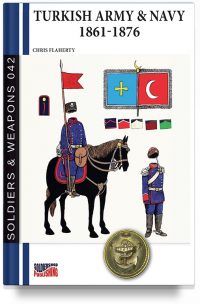
Turkish Army & Navy 1861-1876
- €29,00
- This book looks at the Turkish Army and Navy during the Era of Sultan Abdulaziz, the 32nd Sultan of the Ottoman Empire, who reigned between 25 June 1861 and 30 May 1876. The Army and Navy changed its appearance substantially, from the Crimean War Period. The most notable of the 1861 Era changes was the adoption of a standardized system for rank identification than had existed previously. Based on using an arrangement of gold or silver chevrons placed abouve the…
-
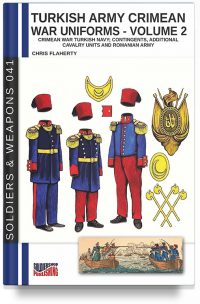
Turkish army Crimean war uniforms – Volume 2
- €29,00
- Volume 1: Turkish Army uniforms in the Crimean War Period, and Volume 2, which covers the Turkish Navy, the Contingents, Additional Cavalry Units and the Romanian Army, both acknowledge as its key source of information, the research by Charles A. Norman, a well-known British military artist and researcher. Norman’s work transliterated original observations, illustrations and notes made by two Crimean War Commentators: Joseph-Emile Vanson, and Constantin Guys. Constantin Guys was a reporter, and illustrator for The Illustrated London News, and…
-
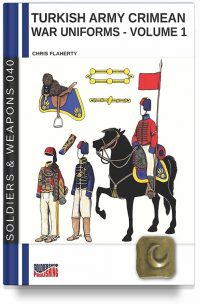
Turkish army Crimean war uniforms – Volume 1
- €29,00
- Volume 1: Turkish Army uniforms in the Crimean War Period, and Volume 2, which covers the Turkish Navy, the Contingents, Additional Cavalry Units and the Romanian Army, both acknowledge as its key source of information, the research by Charles A. Norman, a well-known British military artist and researcher. Norman’s work transliterated original observations, illustrations and notes made by two Crimean War Commentators: Joseph-Emile Vanson, and Constantin Guys. Constantin Guys was a reporter, and illustrator for The Illustrated London News, and…
-
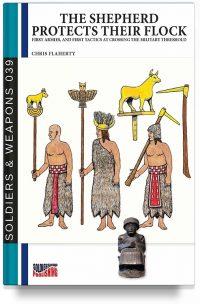
The shepherd protects their flock
- €29,00
- Looking at warfare from the neolithic to sumerians This volume looks back into a huge expanse of time, identifying an historic juncture where feuding became warfare, that was fought by soldiers, during a long historical process called the crossing of the military threshold. This book examines the first tactics used in warfare, weapons and the transition from hunter-warriors to soldiers. Starting with the Neolithic, it then covers the Sumerians and the first micro-armies of soldiers. The process started during Late…
-
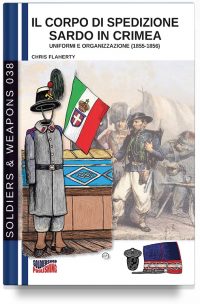
Il corpo di spedizione sardo in Crimea
- €29,00
- L'assedio anglo-franco-ottomano di Sebastopoli, la base navale russa in Crimea, era in corso dall'ottobre 1854. Era iniziato con lo sbarco francese e britannico a Eupatoria il 14 settembre 1854. Il Corpo di Spedizione Sardo (entrato in guerra contro la Russia il 26 gennaio 1855), arrivò a Balaklava nel mese di maggio dello stesso anno. L'esercito del Regno di Sardegna-Piemonte era, per gli standard dell'epoca, considerato moderno e uno dei migliori d'Europa. Le truppe sarde avevano esperienza in battaglia, essendo state…
-
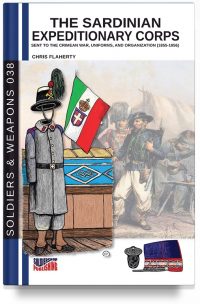
The Sardinian Expeditionary Corps
- €29,00
- The Anglo-French-Ottoman Siege of Sevastopol, the Russian Naval Base in the Crimean, had been underway since October 1854. It had begun with the French and British landing at Eupatoria on 14 September 1854. The late joining of the Sardinian Expeditionary Corps (entering the war against Russia, on 26 January, 1855), arrived at Balaklava over May. The army of the Regno di Sardegna-Piemonte: the Kingdom of Sardinia-Piedmont, was by the standards of the time, seen as modern, and one of the…
-
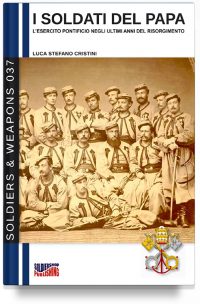
I soldati del Papa
- €25,00
- L'Esercito Pontificio negli ultimi anni del Risorgimento Questo breve saggio sugli ultimi anni della storia dell’esercito del Papa, dal 1860 al 1870, si presenta in veste completamente rinnovata, con immagini inedite e un nuovo testo grazie alla collaborazione di Giancarlo Boeri e Paolo Giacomone Piana, le cui vaste raccolte e la profonda bibliografia hanno permesso di correggere molti errori e ingenuità derivanti dall’uso di fonti non sempre affidabili. Il principale supporto iconografico è costituito dai disegni eseguiti dal cav. Camillo…
-
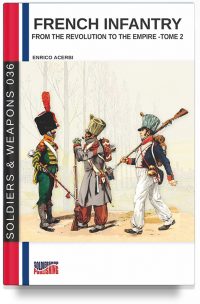
French infantry from the Revolution to the Empire – Tome 2
- €29,00
- In the twenty years, commonly referred to as the Napoleonic period, it was not the flamboyant uniforms of the French cavalry that made the difference on the battlefields of Europe. It was, without doubt, the infantry that interpreted the joys of revolutionary values (the spirit of the volunteers, electoral democracy in ranks, the joy of victory) and also the pains that followed (compulsory conscription, forced marches, diseases and disabilities, and finally, the defeat of Waterloo). Without claiming to be an…
-
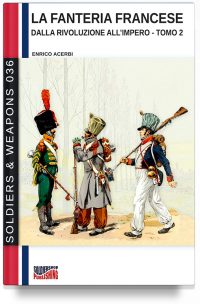
La fanteria francese dalla Rivoluzione all’Impero – Tomo 2
- €29,00
- Nel ventennio, che si definisce comunemente periodo napoleonico, non furono le sgargianti divise della cavalleria francese a fare la differenza sui campi di battaglia d’Europa. Fu, senza dubbio, la fanteria ad interpretare le gioie dei valori rivoluzionari (lo spirito dei volontari, la democrazia elettorale nei gradi, la gioia della vittoria) ed anche i dolori che ne conseguirono (la coscrizione obbligatoria, le marce forzate, le malattie e le menomazioni, ed infine, la sconfitta di Waterloo). Senza aver la pretesa di essere…
-
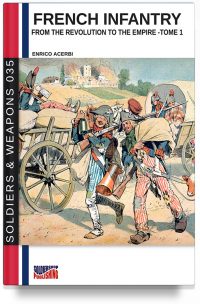
French infantry from the Revolution to the Empire – Tome 1
- €29,00
- In the twenty years, commonly referred to as the Napoleonic period, it was not the flamboyant uniforms of the French cavalry that made the difference on the battlefields of Europe. It was, without doubt, the infantry that interpreted the joys of revolutionary values (the spirit of the volunteers, electoral democracy in ranks, the joy of victory) and also the pains that followed (compulsory conscription, forced marches, diseases and disabilities, and finally, the defeat of Waterloo). Without claiming to be an…
-
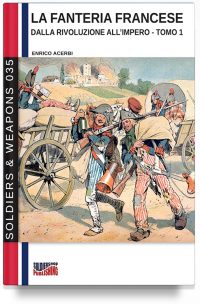
La fanteria francese dalla Rivoluzione all’Impero – Tomo 1
- €29,00
- Nel ventennio, che si definisce comunemente periodo napoleonico, non furono le sgargianti divise della cavalleria francese a fare la differenza sui campi di battaglia d’Europa. Fu, senza dubbio, la fanteria ad interpretare le gioie dei valori rivoluzionari (lo spirito dei volontari, la democrazia elettorale nei gradi, la gioia della vittoria) ed anche i dolori che ne conseguirono (la coscrizione obbligatoria, le marce forzate, le malattie e le menomazioni, ed infine, la sconfitta di Waterloo). Senza aver la pretesa di essere…
-
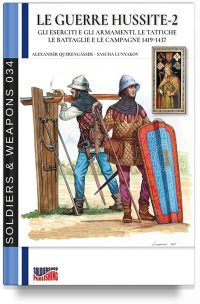
Le guerre Hussite – Vol. 2
- €29,00
- Le guerre contro gli Hussiti furono una serie di guerre di religione contro gli eretici Hussiti, avvenute a più riprese nell'arco di un quindicennio dal 1419 al 1434. L'episodio iniziale, il casus belli, fu offerto dalla prima defenestrazione di Praga nel luglio 1419, quando la fazione taborita, condotta da Jan Troznowski detto Žižka, il condottiero cieco da un occhio, defenestrò sette magistrati del re Venceslao IV (1378-1419), detto il Pigro, che si rifiutavano di rilasciare alcuni loro compagni: i giudici morirono…
-
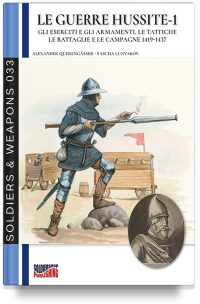
Le guerre Hussite – Vol. 1
- €29,00
- Le guerre contro gli Hussiti furono una serie di guerre di religione contro gli eretici Hussiti, avvenute a più riprese nell'arco di un quindicennio dal 1419 al 1434. L'episodio iniziale, il casus belli, fu offerto dalla prima defenestrazione di Praga nel luglio 1419, quando la fazione taborita, condotta da Jan Troznowski detto Žižka, il condottiero cieco da un occhio, defenestrò sette magistrati del re Venceslao IV (1378-1419), detto il Pigro, che si rifiutavano di rilasciare alcuni loro compagni: i giudici morirono…
